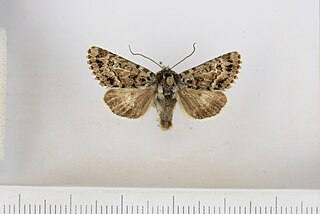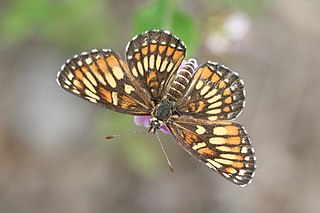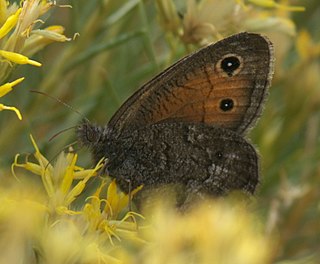
Castilleja, commonly known as paintbrush, Indian paintbrush, or prairie-fire, is a genus of about 200 species of annual and perennial mostly herbaceous plants native to the west of the Americas from Alaska south to the Andes, northern Asia, and one species as far west as the Kola Peninsula in northwestern Russia. These plants are classified in the broomrape family Orobanchaceae. They are hemiparasitic on the roots of grasses and forbs. The generic name honors Spanish botanist Domingo Castillejo.

The variable checkerspot or Chalcedon checkerspot is a butterfly in the family Nymphalidae. It is found in western North America, where its range stretches from Alaska in the north to Baja California in the south and extends east through the Rocky Mountains into Colorado, Montana, New Mexico and Wyoming. The butterfly is usually brown or black with extensive white and yellow checkering and some red coloration on the dorsal wing. Adult wingspan is 3.2–5.7 cm (1.3–2.2 in). Adult butterflies feed on nectar from flowers while larvae feed on a variety of plants including snowberry (Symphoricarpos), paintbrush (Castilleja), Buddleja, Diplacus aurantiacus and Scrophularia californica.

Edith's checkerspot is a species of butterfly in the family Nymphalidae. It is a resident species of western North America and among the subspecies, entomologists have long been intrigued by their many phenotypic variations in coloration, wing length, and overall body size. Most populations are monophagous and rely on plants including Plantago erecta and Orthocarpus densiflorus as their host species in developing from eggs through to larvae, pupae, and mature butterflies. Males exhibit polygyny whereas females rarely mate more than once. Males devote most of their attention to mate acquisition, and such mate locating strategies such as hilltopping behavior have developed. Climate change and habitat destruction have impacted certain subspecies. Three subspecies in particular, Euphydryas editha quino, Euphydryas editha bayensis and Euphydryas editha taylori, are currently under protection via the Endangered Species Act.

Euphydryas editha taylori, the Whulge checkerspot or Taylor's checkerspot, is a butterfly native to an area of the northwestern United States and Vancouver Island.

Dryops is a genus of long-toed water beetles in the family Dryopidae. There are at least 20 described species in the genus Dryops.
Agathymus mariae, the lechuguilla giant skipper, is a species of giant skipper in the family of butterflies known as Hesperiidae. Other common names include Mary's giant skipper and five-spot skipper. It was first described by William Barnes and Foster Hendrickson Benjamin in 1924 and it is found in Central and North America.
Scotogramma fervida is a species of cutworm or dart moth in the family Noctuidae first described by William Barnes and Foster Hendrickson Benjamin in 1912. It is found in North America.

Polia richardsoni is a species of cutworm or dart moth in the family Noctuidae first described by John Curtis in 1834. It is found in North America.

Neogrotella confusa is a moth in the family Noctuidae. The species was first described by William Barnes and Foster Hendrickson Benjamin in 1922 and it is found in North America.

Hydriomena marinata is a species of moth in the family Geometridae first described by William Barnes and James Halliday McDunnough in 1917. It is found in North America.
Scotogramma fieldi is a species of cutworm or dart moth in the family Noctuidae first described by William Barnes and Foster Hendrickson Benjamin in 1927. It is found in North America.

Chlosyne theona, the theona checkerspot, is a species checkerspots in the butterfly family Nymphalidae found in North America. The MONA or Hodges number for C. theona is 4508.

Euphilotes bernardino, the Bernardino blue, is a butterfly in the family Lycaenidae. The species was first described by William Barnes and James Halliday McDunnough in 1916. It is found in North America.

Apodemia mejicanus, the Mexican metalmark or Sonoran metalmark, is a species of butterfly in the family Riodinidae. It was first described by Hans Hermann Behr in 1865. It is found in North America.
Furcula nivea is a moth in the family Notodontidae. It was first described by Berthold Neumoegen in 1891 and it is found in North America.

Historis odius, the orion cecropian, is a species of crescents, checkerspots, anglewings, etc. in the butterfly family Nymphalidae.
Frostia is a genus of soldier beetles in the family Cantharidae. There are about five described species in Frostia.

Cercyonis meadii, or Mead's wood nymph, is a species of brush-footed butterfly in the family Nymphalidae. It was first described by William Henry Edwards in 1872 and it is found in North America.
Euphilotes spaldingi, or Spalding's blue, is a butterfly of the family Lycaenidae. The species was first described by William Barnes and James Halliday McDunnough in 1917. It is found in North America.
Eurois nigra, the great black dart moth, is a species of cutworm or dart moth in the family Noctuidae. It was first described by Smith in 1927 and it is found in North America.













